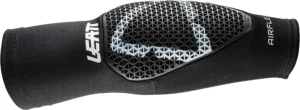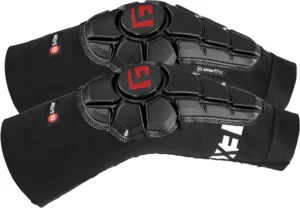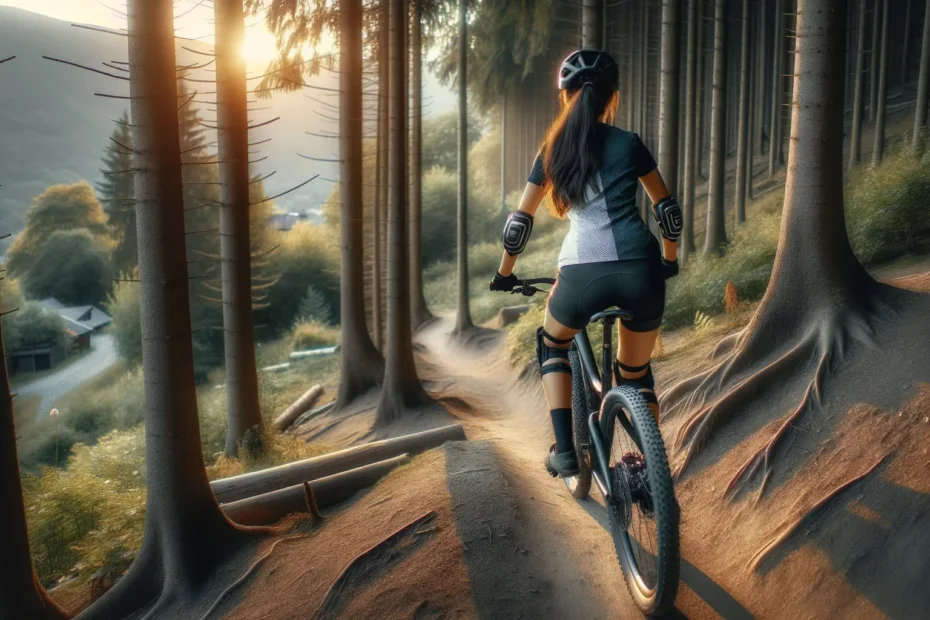Mountain biking can be an fun way to explore nature and get some exercise. However, it does come with some risks.
One of the most common mountain biking injuries is hurting your elbows from falling off your bike. Fortunately, you can help prevent elbow injuries by wearing protective gear like elbow pads.
In this article, we’ll talk all about elbow pads for mountain biking – why they matter, the different types, what features to look for, and how to pick the right pads for your type of riding.
Why Wearing Elbow Pads For Mountain Biking Is So Important
Your elbows don’t have a lot of natural padding so when you fall off your bike and hit a hard rock it hits your bone straight on. that can lead to a broken elbow or bruises or scrapes.
Elbow pads give you that extra layer protection between your elbow and obstacles. A good set of elbow pads will cover your entire elbow as well as part of your arm to protect it from tree branches and stones and whatever else there might be on the trail.
Once you’ve hit your elbows once or twice, you’ll tend to hold back in order to prevent future injury if possible. A quality set of quality elbow pads will give you back the confidence to ride knowing that your elbow can take a hit and you will be fine.
The whole point of elbow pads is to take the impact full force and cushion your elbow from being damaged. Besides direct hits which can cause bone damage, there are many times that you get scrapes on your arms from low hanging branches or thorns or things like that on the trail. Elbow pads protect you from that as well because they typically cover part of the forearm and bicep as well.
As you can see, elbow pads provide a lot of benefit for the low cost involved.
Types of Mountain Bike Elbow Pads
When choosing elbow pads for mountain biking, you’ll come across a few main types of MTB elbow pads:
Hard Shell Elbow Pads
These pads have a hard outer shell made of plastic over top of impact foam. The outer shell is usually polycarbonate of ABS plastic. Inside is usually either EVA form or polyethylene foam.
I mention this for completeness, but frequently these are overkill for mountain biking and reserved more for motocycle user or perhaps even extreme downhill with some serious jumps. Many manufacturers do have a couple of products with hard plastic in a form like the Leatt AirFlex (these are actually very flexible but just trying to give an idea of what a plastic shell looks like).

Hard shell elbow pads offer the most protection you can get and if usually for the more aggressive riding since the outer shell is highly resistant to scratches, sliding on them, or encountering sharp edges. The outer shell takes the brunt of the hit and spreads it across the impact foam.
They are usually, by design, very durable and resistant to weather like rain and snow. Hard shells are also pretty easy to clean with a simple rag as opposed to having to soak softer elbow sleeves to clean them.
The downside of course to all of that protection is that they are not flexible at all. The hard shell likes to stay the way it is so it’s like riding with a board strapped to your elbow. They are bulky and since they don’t flex that well, you will have to adjust them constantly.
But if you need that level of protection, they are the best at protecting your elbows and arms.
Soft Shell Elbow Pads
Soft shell pads use materials that more flexible than their hard plastic counterparts. They also tend to be a bit more breathable. The outer shell is more than fabric but has a type of shell still. A good example is the G-Form Pro X3.

These have a shell of a sort, but it’s flexible enough to wear fairly often and it still feels comfortable. Underneath the soft shell is usually padded foam of some type or even a non-Newtonian compound like the SmartFlex in the Pro X3 above.
These pads do a great job of protecting elbows and the arm area close to them. They protect more than just a sleeve but less than a hard shell. They really protect more than a sleeve if you’re talking about sliding on your elbows after flying off your bike for instance.
The benefit of these is that you can move you arms far easier than a hard shell. The fabric tends to move and stretch much easier so that it fits well but also doesn’t hinder your movements on the trail. Generally they stay in place pretty well when riding.
Soft shell pads tend to breathe better as well thanks to moisture-wicking fabrics and that the shell itself isn’t completely sealed so you can get air flow through it too. That all helps to keep your arms cooler while riding which makes for a more pleasant ride.
Sleeve Style Mountain Bike Elbow Pads
Sleeve style are by far the most common type of mtb elbow pads you’ll find on the market, mostly because they are the best choice for most types of riding.
Sleeve-style elbow pads slip on over your arm and have silicone bands to keep them from slipping. They typically have either impact foam of an advanced compound such as D30 or VPD so that they are very flexible, but when they take an impact they can easily take it
This type of design is easy to get them on and off as needed, but snug enough that they stay in place through the whole ride. This kind works great for enduro, trail, cross-country, and more. For instance, this makes it much easier to take off equipment and put on different equipment in enduro racing.
The main drive behind the sleeve style is that they are stretchy and very flexible and feel comfortable and natural enough that you often forget you are even wearing them. The sleeve protects your arms from sticks and such on the trail, and the impact pad protects you in case you hit something hard. They won’t have quite the protection of the hard shell pads, but how often are those even necessary. I can tell you from experience that for 90% of riding the sleeve style works great.
Kids Elbow Pads
It’s very important for the younger riders to have elbow protection that’s geared towards the size kids need. I created a guide on choosing MTB elbow pads for kids to help you learn what’s needed to ensure they stay safe out there.
Women’s Elbow Pads
Not all men’s elbow pads will fit women properly to protect them on the trails. I put together an article on choosing MTB elbow pads for women to help with finding the best fit and style for female riders.
Key Features To Look For In MTB Elbow Pads
Now the fun part. You know what types there are a bit more about them, but how do you know how to choose the right ones for you?
Correct Fit
Elbow pads that fit properly will fit snug without feeling like they’re actually restricting your arm movement in any way. If the pads are too loose on your arm, they will shift around while you’re riding and you will constantly have to readjust them. if they’re too tight you will feel like you can’t move your arm properly and it will not be comfortable.
Most manufacturers provide sizing charts based on arm circumference to help you choose the proper size. You’ll want to measure your upper arm around the mid bicep area and just below the elbow to use for the charts.
Some elbow pads such as POC also have adjustable straps that will let you get a little bit extra tightness if you need it beyond the normal fit. Most of the elbow pads are made of material that stretches so you’ll want it slightly snug.
Protective Padding
There are two types of padding: traditional and non-Newtonian padding.
Traditional padding are either EVA foam or polyethylene foam. More or less the same foam they’ve been putting in pads for a long time.
The newer type of compound is a non-Newtonian compound. It is very flexible and comfortable to have in your elbow pads. Far less resistance than from impact foam. However, when it takes a sharp hit, the material hardens up instantly to provide some serious impact protection. It’s very cool stuff and about as cutting-edge as it gets. This is typically what you see with D30, VPD, or SmartFlex material from the big names.
If you are looking at pads with foam, then the thicker the foam, the better the protection. However, the thicker the foam, the hotter they are to wear and also the less flexible. So it’s a trade off.
The newer compounds are interesting because they aren’t very thick but provide great protection. They are even flexible more than you would think. However, these are also generally more expensive. They also are generally cooler to wear because they aren’t thick foam which blocks all air.
If you’re saving a few bucks, the foam-based ones are a good bet, but there are some like the TLD Speed Sleeves that are the more advanced padding but fairly comparable price-wise to the foam.
I have some good recommendations on my list of the best mtb elbow pads if you want to get an idea of some good choices and why they are good choices. I also put together an article on the materials and technologies they are using in elbow pads if you’d like to learn more about it.
Secure Fastenings
Most of the elbow pads utilize sleeves that slip on and have silicone grippers are both ends as well as usually a silicone stripe that runs on the inside of the sleeve. Silicone grips well even when wet so they can stay in place well even when you’re really sweating.
The key is to make sure, while your arms are dry and before a run, to make sure the pads are just where you want them to be. Once they get wet, they are usually harder to move which is good if they were in the right place to start with.
Some pads like POC even have a strap that can be tightened to help them stay in place even better. The real key with all of us is to carefully measure your arms to get the right size per the manufacturer sizing charts so that they are snug to begin with and then this is all easy.
Breathable Fabrics
Unless you’re riding in the winter in some cold temperatures, you want the elbow pads to breathe to let the sweat dry but mainly for the air to cool down your arms to keep them from overheating. Nobody likes hot, sweaty, clammy skin because it gets uncomfortable on the trails.
You want elbow pad sleeves that have an open mesh fabric that will let air come through freely. Around the elbow pads itself is a little tougher to get airflow and typically that part of the elbow pads is a little warmer.
Soft shell pads can stay as cool as sleeves due to the fabric breathing, but hard shell pads typically run much hotter because the shell is waterproof so it will actually hold in the sweat until it’s dripping.
So you can see why elbow sleeves are very popular for most riding.
Durability & Product Lifespan
Elbow pads take wear and tear from taking them on and off, rubbing against tree branches, UV affecting the material, and cleaning them. Unfortunately, it’s not too easy to tell how well one will hold up just by looking at it.
Given enough time, all elbow pads are going to start to break down and need to be replaced. However, ideally you’ll use it for quite a few seasons before that happens. The average for a set is 2-5 years depending on usage.
This is a good one where you want to see how the community weighs in on elbow pads because that’s a lot of time in use all together. Many brands like TLD, Fox, POC, and G-Form have enough usage you can get a good feel for what you’re looking at.
Actually, I can say that finding out what’s popular in the community for elbow pads is a big factor in how to choose mtb elbow pads.
